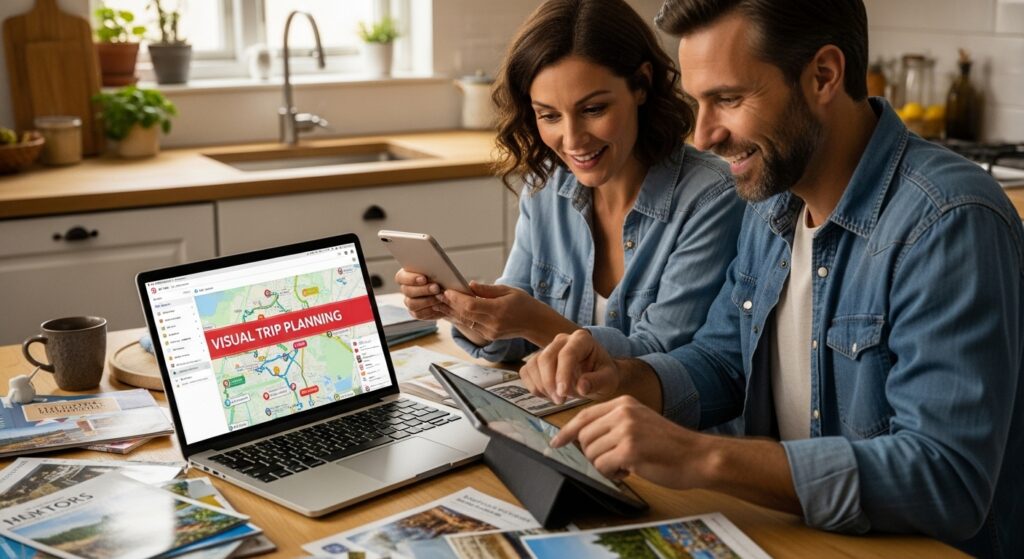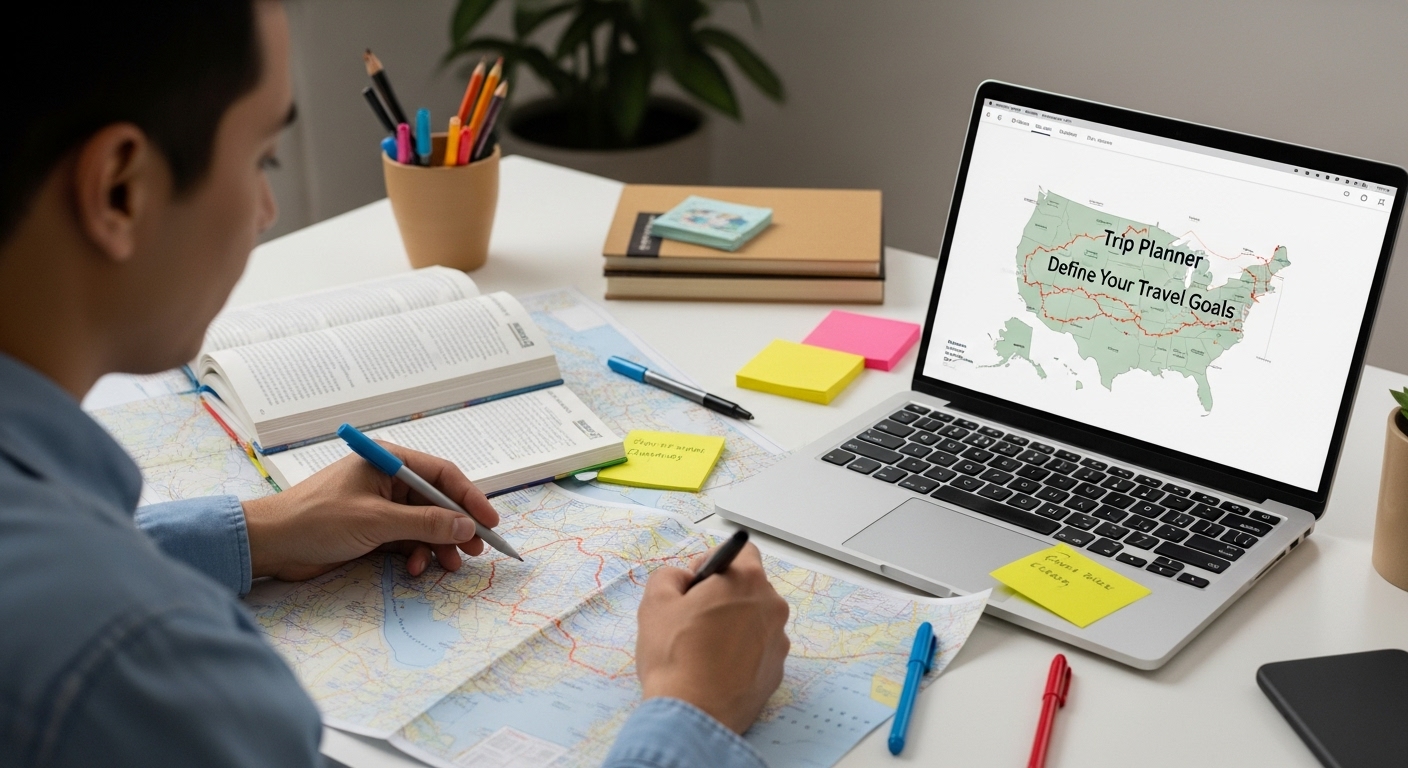Planning a trip used to mean walls of spreadsheets and endless lists. Now, visual trip planning platforms let you see your whole journey come alive right on your screen. But what really turns heads is that studies show visual trip tools can slash travel anxiety and help you make smarter choices before you even leave home. Most travelers are shocked when they realize that these tools do more than organize logistics—they actually transform stress into excitement.
Table of Contents
- Defining Visual Trip Planning: What Is It?
- The Importance of Visual Trip Planning for Travelers
- How Visual Trip Planning Works: Key Concepts Explained
- Practical Applications of Visual Trip Planning for Your Journeys
- Real-World Impact: Visual Trip Planning in Action
Quick Summary
| Takeaway | Explanation |
|---|---|
| Visual trip planning enhances travel preparation | Utilize digital technologies to create intuitive, interactive travel experiences instead of traditional methods. |
| Interactive maps simplify route assessment | View destinations and routes visually to better understand travel times, distances, and connections. |
| Reduces travel anxiety through visualization | Clear visual tools provide predictable previews of journeys, diminishing uncertainty and stress. |
| Supports personalized travel exploration | Customize routes and discover attractions that align with individual preferences and travel goals. |
| Promotes sustainable travel choices | Visual platforms highlight the environmental impact of different transportation options for informed decision-making. |
Defining Visual Trip Planning: What is it?
Visual trip planning represents a transformative approach to travel preparation that leverages digital technologies to create intuitive, interactive, and comprehensive travel experiences. Unlike traditional planning methods involving spreadsheets or paper documents, visual trip planning integrates mapping, multimedia elements, and smart design to help travelers conceptualize and organize their journeys more effectively.
To help clarify how visual trip planning differs from traditional trip planning, the table below compares their core features and user benefits side by side.
| Aspect | Traditional Trip Planning | Visual Trip Planning |
|---|---|---|
| Format | Spreadsheets, paper notes | Interactive maps and digital interfaces |
| Route Visualization | Text-based, static lists | Real-time graphical maps |
| Flexibility | Manual edits, less dynamic | Drag-and-drop, dynamic adjustments |
| Information Integration | Separate sources, manual entry | Integrated bookings, real-time data |
| User Experience | Can feel overwhelming and linear | Intuitive, interactive, and engaging |
| Anxiety Reduction | Limited predictability | High predictability and control |
| Personalization | Basic customization | High personalization of routes and attractions |
The Core Concept of Visual Representation
At its fundamental level, visual trip planning transforms complex travel logistics into easily digestible visual formats. Understanding the role of trip visualization helps travelers see their entire journey as an interconnected experience rather than isolated segments. This approach allows individuals to:
- View destinations and routes on interactive maps
- Understand geographical relationships between different locations
- Estimate travel times and distances more accurately
- Identify potential connections and optimize travel paths
By presenting travel information graphically, these tools make planning more engaging and less overwhelming.
 Travelers can literally see their potential routes, attractions, and logistics in a single comprehensive view.
Travelers can literally see their potential routes, attractions, and logistics in a single comprehensive view.
Technology Driving Visual Trip Planning
Modern visual trip planning leverages advanced technologies like geospatial mapping, artificial intelligence, and user interface design. According to research from the Watson Institute, visual representations can significantly reduce travel anxiety by providing clear, detailed previews of upcoming experiences.
These digital platforms typically incorporate features such as drag-and-drop interfaces, real-time location tracking, personalized recommendations, and integrated booking systems.
The following table summarizes the main technological features found in modern visual trip planning platforms, along with the user benefits they deliver.
| Technology Feature | Description | User Benefit |
|---|---|---|
| Geospatial Mapping | Real-time maps and route visualization | Easy understanding of routes and destinations |
| Artificial Intelligence | Personalized recommendations based on preferences | Efficient itinerary creation and customization |
| Drag-and-Drop Interface | Simple manipulation of routes and attractions | Quick and intuitive trip adjustments |
| Real-Time Data Integration | Live updates on traffic, weather, and transit | Better decision making and scheduling |
| Integrated Booking Systems | Seamless reservations within the platform | Streamlined planning and reduced hassle |
The goal is to transform complex travel planning from a potentially stressful task into an intuitive, enjoyable process that empowers travelers to make informed decisions quickly and confidently.
The Importance of Visual Trip Planning for Travelers
Visual trip planning has transformed how travelers approach journey preparation, offering significant advantages that extend far beyond traditional travel organization methods. By converting complex travel logistics into intuitive visual experiences, these digital tools provide travelers with unprecedented control, clarity, and confidence in their trip planning process.
Enhancing Decision Making and Traveler Confidence
Modern travelers require more than just basic itinerary information. Understanding the importance of trip organization reveals how visual representations enable more informed and strategic travel decisions. These visual planning tools help travelers:
- Quickly assess multiple route options
- Evaluate travel time and potential constraints
- Understand geographical relationships between destinations
- Anticipate potential challenges before departure
By presenting information graphically, travelers can make more nuanced decisions that consider factors beyond simple distance or cost. The visual approach transforms abstract travel details into comprehensible, actionable insights.
Reducing Travel Anxiety and Improving Experience
According to research from Purdue University, visual information processing significantly reduces travel-related stress. Interactive maps and visual itineraries provide travelers with a sense of predictability and control, which are crucial psychological factors in enjoying travel experiences.
Visual trip planning tools mitigate uncertainty by offering comprehensive previews of routes, potential stops, estimated travel times, and even contextual information about destinations. This approach helps travelers feel more prepared and confident, transforming the planning phase from a potentially overwhelming task into an exciting part of the journey itself.
How Visual Trip Planning Works: Key Concepts Explained
Visual trip planning operates through sophisticated digital technologies that transform complex travel information into intuitive, interactive experiences. These systems integrate multiple data sources and advanced visualization techniques to help travelers plan and navigate their journeys with unprecedented precision and ease.
Data Integration and Mapping Technologies
How to create an itinerary for a trip becomes significantly more efficient through advanced geospatial mapping technologies. These platforms combine various data streams including:
- Geographic location information
- Transportation routes and networks
- Real-time traffic and transit data
- Points of interest and attractions
- Weather and seasonal conditions
By synthesizing these diverse information sources, visual trip planning tools create comprehensive, dynamic representations of potential travel routes and experiences. The mapping technology allows users to interact with geographical data in ways traditional paper maps never could.
Interactive User Experience Design
According to research from the Complete Trip Concept, modern visual trip planning platforms focus on creating seamless, user-friendly interfaces that enable travelers to manipulate and customize their travel plans instantly.
These systems typically feature drag-and-drop interfaces, allowing users to rearrange destinations, adjust routes, and modify itineraries with simple gestures. Advanced algorithms provide intelligent recommendations based on user preferences, travel history, and real-time contextual information, transforming trip planning from a static process into a dynamic, personalized experience.
Practical Applications of Visual Trip Planning for Your Journeys
Visual trip planning transcends theoretical concepts by offering tangible, real-world solutions for travelers across various scenarios. These digital tools provide practical applications that simplify complex travel logistics and empower individuals to create more meaningful, efficient journeys.
Personalized Travel Exploration
Understanding the role of trip visualization reveals how travelers can customize their experiences with unprecedented precision. Visual trip planning enables individuals to:
- Design custom routes tailored to personal interests
- Discover hidden attractions near primary destinations
- Optimize travel time and minimize unnecessary detours
- Calculate realistic budgets based on geographical proximity
- Integrate multiple transportation modes seamlessly
These platforms transform travel from a generic experience into a highly personalized adventure, allowing users to craft journeys that reflect their unique preferences and constraints.

Multi-Purpose Travel Scenario Planning
According to research from the National Center for Applied Transit Technology, visual trip planning proves invaluable across diverse travel scenarios. Whether planning a family vacation, business trip, or solo adventure, these tools offer adaptable solutions that address varying traveler needs.
Business travelers can strategically map client meetings, leisure travelers can explore scenic routes, and adventure seekers can plan complex multi-destination journeys with unprecedented ease. The ability to visualize entire travel experiences before departure reduces uncertainty and enhances overall trip satisfaction.
Real-World Impact: Visual Trip Planning in Action
Visual trip planning has transitioned from a technological novelty to a transformative tool that fundamentally changes how travelers interact with their journeys. By translating complex travel information into intuitive, interactive experiences, these digital platforms are reshaping navigation, decision making, and overall travel experiences across multiple sectors.
Enabling Smarter Travel Decisions
Understanding personalized travel itinerary reveals how visual technologies empower travelers to make more informed choices. These platforms provide real-time insights that help individuals:
- Evaluate multiple transportation options
- Assess potential environmental impacts of travel choices
- Calculate precise cost comparisons
- Understand time and resource trade-offs
- Predict potential travel challenges
The ability to visualize multiple scenarios simultaneously allows travelers to make decisions that balance convenience, efficiency, and personal preferences with unprecedented accuracy.
Transforming Sustainable Travel Experiences
According to research examining travel information visualization, making travel information explicit through visual presentations can significantly influence travelers’ transportation choices. By presenting comprehensive, graphical representations of journey options, these tools encourage more environmentally conscious decision making.
Modern visual trip planning platforms go beyond simple route mapping. They integrate ecological considerations, providing travelers with transparent information about the carbon footprint of different travel modes. This approach not only simplifies navigation but also promotes more sustainable travel behaviors by making environmental impact immediately visible and comprehensible.
Stop Struggling with Complicated Travel Planning—Experience the Power of Visual Trip Planning
Are you tired of losing time juggling messy spreadsheets, scattered notes, and endless tabs while planning your next adventure? The article above explains how visual trip planning can transform overwhelming logistics into a clear, interactive experience, helping you see your trip as a single, connected journey. But if you still feel anxious about missing key details or wish you could organize everything in one place with just a few clicks, you are not alone. Yopki was designed for travelers who want clarity, simplicity, and confidence in their planning process.

Discover how Yopki creates your entire itinerary instantly based on your interests. Drag and drop destinations right onto a smart map, visualize your trip in a whole new way, and keep all your bookings in one easy hub. Let your journey start with a single click today. Visit Yopki to try visual trip planning for yourself and turn your dreams into realities with zero stress.
Frequently Asked Questions
What is visual trip planning?
Visual trip planning is a modern approach to organizing travel that uses digital tools to create interactive maps and visual itineraries, making it easier for travelers to conceptualize and plan their trips.
How does visual trip planning enhance the travel experience?
Visual trip planning enhances the travel experience by providing comprehensive visual representations of travel routes, estimated travel times, and attractions, helping travelers make informed decisions and reducing anxiety related to journey preparation.
What technologies are used in visual trip planning?
Visual trip planning leverages advanced technologies such as geospatial mapping, artificial intelligence, and user-friendly interface design to integrate various data sources and create dynamic travel experiences.
How can visual trip planning help in reducing travel-related stress?
By offering intuitive visual representations of travel logistics, visual trip planning tools provide a sense of control and predictability, which can significantly reduce travel-related stress and improve overall trip satisfaction.



